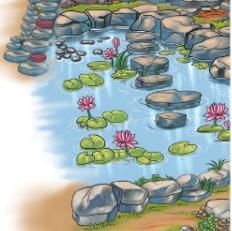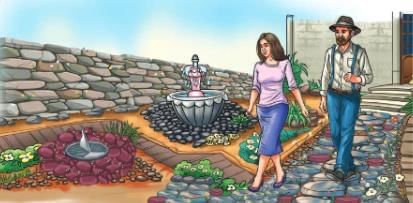Short and Long Answer Questions: A Concrete Example | English Poorvi Class 8 - New NCERT PDF Download
Short Answer Questions
Q1. Why does the poet repeat the phrase “My next-door neighbour, Mrs. Jones” in each stanza?
Ans: The poet repeats “My next-door neighbour, Mrs. Jones” to emphasize her importance as the central character in the poem. This repetition creates a rhythmic pattern, making the poem catchy and easy to follow. It also highlights her quirky personality and her unique garden, keeping the focus on her throughout. This repetition adds a fun, musical quality to the poem’s structure.
Q2. How does the poet use humor in the second stanza when describing the tiny plants?
Ans: In the second stanza, the poet uses humor by describing the tiny plants as so small they “don’t mean anything at all.” He jokingly suggests Mrs. Jones might plant them with a pin, which is an exaggerated and funny idea. This humor comes from the speaker’s surprise at how she manages to place such delicate plants in tight spaces. The playful tone makes the poem enjoyable and shows the speaker’s amusement at her gardening.

Q3. What does the “crazy path” in Mrs. Jones’s garden tell us about her garden’s design?
Ans: The “crazy path” suggests that Mrs. Jones’s garden has an unusual, winding path that isn’t straight or typical. It reflects her unique and quirky approach to gardening, where stones dominate instead of flowers or grass. This path adds to the garden’s charm, showing her love for an unconventional design. It makes the garden stand out as different, appealing to her creative taste.
Q4. How does the sundial’s “strange device” contribute to the poem’s description of the garden?
Ans: The sundial’s “strange device” adds an element of oddity to Mrs. Jones’s garden, making it more unique. It shows that even the sundial, a time-telling tool, has an unusual design that she finds appealing. This detail highlights her quirky taste, as she values things others might find strange. It helps paint a picture of a garden full of unexpected and charming features.

Q5. Why does the speaker find the tiny plants amusing in the poem?
Ans: The speaker finds the tiny plants amusing because they are so delicate and small that they seem unimportant to him. He humorously wonders how Mrs. Jones plants them in the tight spaces between stones, even joking about using a pin. Their tiny size contrasts with the large stones, making her effort seem surprising and funny. This amusement reflects the speaker’s playful perspective on her quirky gardening.
Q6. What role does the lily pond play in Mrs. Jones’s stone-filled garden?
Ans: The lily pond adds a touch of beauty and variety to Mrs. Jones’s stone-filled garden. It contrasts with the hard stones by including soft water lilies, showing her garden isn’t just about rocks. The pond makes the garden more interesting and reflects her creative approach to gardening. It also suggests she values natural elements, even in her unique stone-focused design.

Q7. How does the poem’s rhyme scheme enhance its overall effect?
Ans: The poem’s AABBCC rhyme scheme gives it a musical and playful rhythm, making it fun to read. Each pair of lines rhymes, like “Jones/stones” and “pond/beyond,” which keeps the poem flowing smoothly. This structure makes the poem easy to follow and enjoy. The consistent rhymes also match the light-hearted tone, enhancing the humor and charm.
Q8. What does the speaker’s question “Where is this lovely thing?” reveal about their perspective?
Ans: The speaker’s question “Where is this lovely thing?” shows they are curious and engaged but unaware of the flower’s tiny size. They expect to see something obvious, not a delicate plant underfoot. This reveals their different perspective from Mrs. Jones, who values the small details. It sets up the humorous twist, highlighting their obliviousness in a playful way.
Q9. How does Mrs. Jones’s response “You’re standing on it” add to the poem’s humor?
Ans: Mrs. Jones’s response “You’re standing on it” is funny because it reveals the speaker’s mistake of stepping on the tiny flower they were admiring. Her calm reply contrasts with the speaker’s surprise, creating a humorous moment. This twist shows how easily small things can be overlooked, adding irony. It makes the poem entertaining by showing a light-hearted blunder.
Q10. How does the poem show the theme of connection with nature through Mrs. Jones?
Ans: The poem shows connection with nature through Mrs. Jones’s love for her garden, even though it’s mostly stones. She carefully places tiny plants and cherishes features like the lily pond and rockery. Her enthusiasm for these natural elements, despite their unusual setting, reflects her joy in gardening. This connection highlights how nature can bring happiness in unique ways.
Q11. What makes Mrs. Jones’s gardening style different from typical gardens?
Ans: Mrs. Jones’s gardening style is different because her garden is filled with stones rather than flowers or grass. She includes unique features like a crazy path, rockery, and sundial, unlike typical plant-heavy gardens. Her focus on tiny plants placed between stones shows her quirky approach. This unusual style makes her garden stand out as special and creative.
Q12. How does the poem encourage readers to find humor in daily life?
Ans: The poem encourages finding humor in daily life through the funny interaction where the speaker steps on the flower. The speaker’s mistake and Mrs. Jones’s calm response create a light-hearted moment. The playful tone and exaggerated ideas, like planting with a pin, add to the fun. It shows that everyday blunders can be amusing and worth laughing about.

Long Answer Questions
Q1. How does the poet use the setting of Mrs. Jones’s garden to reflect her personality?
Ans: The setting of Mrs. Jones’s garden, filled with stones, reflects her quirky and unique personality. Unlike typical gardens with flowers and grass, her garden has a crazy path, a lily pond, a rockery, and a sundial with a strange design, showing her love for unusual things. Her enthusiasm for placing tiny plants between stones highlights her patience and attention to detail. The poet describes these features to show that Mrs. Jones finds beauty in what others might see as odd. Her pride in the garden’s unique elements, like the sundial’s strange device, suggests she values creativity over convention. This setting makes her stand out as an eccentric yet charming character.
Q2. Why is the title “A Concrete Example” significant for the poem’s message?
Ans: The title “A Concrete Example” is significant because it refers to the tangible, real-life example of Mrs. Jones’s stone garden to convey the poem’s message. The word “concrete” suggests something solid, like the stones that dominate her garden, which is an unusual choice for beauty. The title highlights how her garden is a real example of finding beauty in unexpected places, a key message of the poem. It also hints at the humor in the speaker’s mistake of stepping on a plant, a concrete moment of irony. By using this title, Reginald Arkell emphasizes that everyday experiences, like visiting a neighbor’s garden, can teach us to appreciate different perspectives. The title connects to the theme of perception versus reality, as Mrs. Jones sees value in her stones while the speaker does not.
Q3. How does the poet create a sense of surprise in the final stanza of the poem?
Ans: In the final stanza, the poet creates a sense of surprise through the unexpected twist when Mrs. Jones reveals the speaker is standing on the flower they are admiring. The speaker spends fifteen minutes talking about the flower, building anticipation that it must be noticeable and beautiful. When the speaker asks, “Where is this lovely thing?” they expect to see something obvious, making Mrs. Jones’s calm reply, “You’re standing on it,” shocking and funny. This contrast between the speaker’s expectation and the reality of stepping on a tiny plant creates a moment of irony. The poet’s use of dialogue adds to the surprise, as Mrs. Jones’s response is direct and understated. The surprise is effective because it shows how small details can be overlooked, a key theme.
Q4. How does the poem illustrate the theme of human quirks through Mrs. Jones’s actions?
Ans: The poem illustrates the theme of human quirks through Mrs. Jones’s unique gardening choices and her enthusiasm for them. She creates a garden filled with stones, including a crazy path, rockery, and sundial, which is unusual compared to typical flower gardens. Her careful placement of tiny, delicate plants between stones shows her dedication to an unconventional hobby. This quirkiness is evident in her pride for the sundial’s strange design, which she finds “rather nice.” The poet highlights her individuality by showing how she values things others might find odd. Her calm reaction to the speaker stepping on her flower further reflects her quirky, easygoing nature.
Q5. How does the poet’s use of imagery make the garden vivid for readers?
Ans: The poet uses vivid imagery to bring Mrs. Jones’s garden to life, making it easy for readers to picture it. He describes a “crazy path” that twists and turns, suggesting an unusual and lively design. The “lily pond” evokes images of water lilies floating in a serene pool, adding a soft contrast to the stones. The “rockery” paints a picture of carefully arranged stones, showing her artistic touch. The “sundial with a strange device” creates an image of an odd, eye-catching tool that stands out. The tiny plants “delicate and small” between stones add a sense of fragility and detail. These images make the garden feel real and unique. The poet’s word choices create a clear, colorful picture that enhances the poem’s playful tone. This vividness helps readers connect with Mrs. Jones’s quirky world.
Q6. How does the poem show the importance of appreciating small details in life?
Ans: The poem shows the importance of appreciating small details through Mrs. Jones’s care for her tiny plants and the speaker’s failure to notice them. Mrs. Jones lovingly places delicate plants between stones, valuing them despite their small size. The speaker, however, thinks they “don’t mean anything at all,” missing their significance until he steps on one. This contrast highlights how small things can matter to someone, like Mrs. Jones, who finds joy in them. The humorous twist of the speaker’s mistake teaches that overlooking details can lead to funny blunders. The poem shows that paying attention to little things, like a tiny flower, can deepen our appreciation of others’ passions. The poet’s playful tone makes this lesson engaging and easy to understand. It encourages readers to notice and value small details in their own lives. The poem’s message is clear: small things can hold big meaning if we look closely.
Q7. How does the poet’s choice of first-person narration affect the poem’s tone and perspective?
Ans: The poet’s choice of first-person narration, using “I” and “me,” makes the poem feel personal and relatable, as if the speaker is sharing a real story. This perspective allows readers to see the garden through the speaker’s amused and slightly puzzled eyes, creating a playful tone. The speaker’s thoughts, like wondering if Mrs. Jones uses a pin to plant, add humor and show their curiosity. By narrating in the first person, the poet makes the speaker’s mistake of stepping on the flower more engaging, as readers feel part of the blunder. This perspective contrasts with Mrs. Jones’s view, highlighting the theme of perception versus reality. The first-person voice feels like a friend telling a funny story, making it easy to connect with. It also makes the tone light-hearted and intimate, drawing readers into the poem’s world. The narration keeps the focus on the speaker’s experience, enhancing the humor and charm.
|
58 videos|435 docs|57 tests
|
FAQs on Short and Long Answer Questions: A Concrete Example - English Poorvi Class 8 - New NCERT
| 1. What are the key components of a successful short answer response in exams? |  |
| 2. How should students approach long answer questions in their exams? |  |
| 3. What strategies can help improve performance in short and long answer questions? |  |
| 4. Why is it important to use appropriate terminology in exam responses? |  |
| 5. How can students effectively manage their time during exams with short and long answer questions? |  |
















